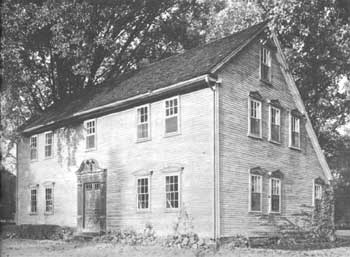





Survey of
Historic Sites and Buildings
 |
OLD DEERFIELD Massachusetts |
|
| ||
Ownership and Administration (1961). Homes privately owned; museum and museum houses owned and administered by Heritage Foundation and Pocumtuck Valley Memorial Association; buildings owned by Deerfield Academy.
Significance. Deerfield was the northernmost outpost of the New England frontier at the end of the 17th century. Its name lives in history as a symbol of the hardship endured and the final triumph won by the settlers who challenged the French and Indians of the interior. Negotiations with the Pocumtuck Indians in 1667 opened to white settlement a tract of 8,000 wilderness acres in the Connecticut Valley. The Indians received fourpence an acre for the land, a price that the white men considered very liberal. The first settlers arrived in the spring of 1669, and by 1673 twenty families had broken ground for farms, laid out a village street and set aside house lots much as they exist today. In the latter year the colonists established an independent town whose name soon began to appear on official documents as Deerfield.
The people of Deerfield lived in constant apprehension of Indian attacks. A series of Indian raids in September 1675 brought death to many men and forced the survivors to retreat to the south. Despite this setback, Deerfield was reoccupied and built anew within a few years, stronger than before. As evidence of its new strength, in September 1694 the fortified village rallied and beat off a surprise attack by Indians under French leaders.
Deerfield was still the northernmost colonial outpost on the Connecticut River at the opening of the 18th century. When Queen Anne's War broke out in 1702, the French made haste to ally themselves with the Indians for the purpose of attacking Deerfield. A force of 200 French regulars and nearly 150 Indian warriors swept down on Deerfield at daybreak on February 29, 1704, surprised the sentries and threw open the gate of the stockade that surrounded the village. The struggle raged for 5 hours. More than half the population perished or were seized as prisoners, and nearly half the houses were looted and burned. Only the timely arrival of reinforcements from settlements to the south saved Deerfield from total disaster. The French and Indians withdrew to Canada with more than a hundred prisoners—men, women, and children—many of whom were later released.
Troops took station at Deerfield to prevent a recurrence of this catastrophe, and slowly the settlement was reborn. Occasional minor raids continued to plague the town until the final major attack in 1746, but never again did the town suffer the horror of 1704. Deerfield was well on the way to prosperity as a wheat and cattle center by the middle of the 18th century, and its inhabitants reflected the better times in their comfortable homes and household treasures. This period of dawning refinement and taste is reflected today in many of the 18th-century dwellings of Old Deerfield.
The outbreak of the Revolution brought tension again to Deerfield. Some inhabitants remained aggressively loyal to the King while others embraced the patriot cause with equal ardor. When hostilities opened at Lexington and Concord, Deerfield sent its young men to war and then served as a supply center for American troops operating in the region.
The town won a new reputation as a center of education after the establishment of Deerfield Academy in 1797. Deerfield largely escaped the currents of progress and growth that rapidly transformed other communities of the young Republic. Spared in great measure from the impact of modern urban and industrial development, Old Deerfield is today a memorable evocation of America's colonial frontier.
 |
| John Williams House: Williams was the first resident minister of Deerfield, who was captured by Indians and later released. The citizens of Deerfield voted in town meeting, in January 1706, to build a new house for him. This structure serves today as a dormitory for Deerfield Academy. (National Park Service) |
Present Appearance (1961). Old Deerfield consists principally of an unusual collection of dwellings dating from the 18th and early 19th centuries together with public buildings extending for a mile along elm-shaded Old Deerfield Street. Among the most notable of these structures, open to the public, are the Frary House, part of which antedates the massacre of 1704; the Sheldon-Hawks House, built in 1734; the Ashley House, dating from the early 18th century; and the Asa Stebbins House, finished in the 1790's. Memorial Hall, built in 1799 for Deerfield Academy, is on Memorial Road just off Old Deerfield Street. The building now serves as a museum housing an outstanding collection of furniture, pewter, household objects, farm implements, and other items relating to early Deerfield and the New England colonial period. Among the museum exhibits is a heavy, nail-studded door identified as being from the original Sheldon Tavern. In the door are holes chopped by the Indians in an effort to break into the fortified house during the fighting of February 29, 1704. Although all the houses are not open to the public, many have been carefully restored to preserve the atmosphere of a village that, while meeting the needs of the modern day, illustrates the charm, craftsmanship, and discrimination of the period when Old Deerfield rose from the ruins of frontier war. [80]
NHL Designation: 10/09/60
 |
 |
http://www.cr.nps.gov/history/online_books/colonials-patriots/sited1.htm
Last Updated: 09-Jan-2005